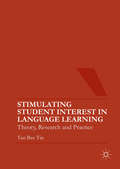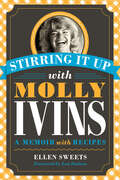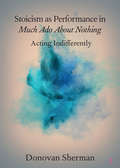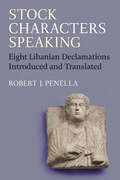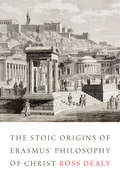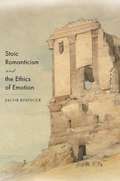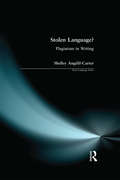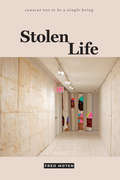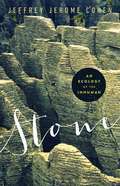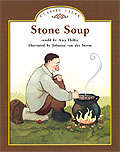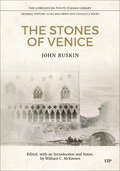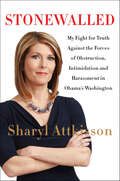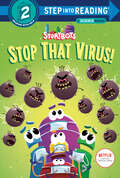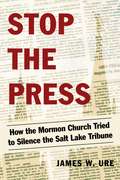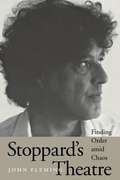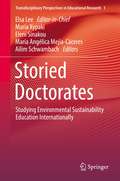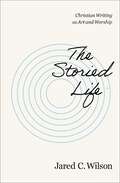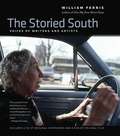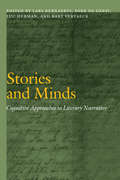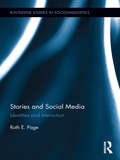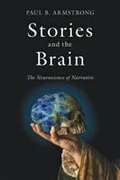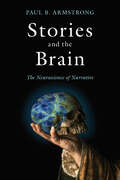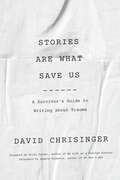- Table View
- List View
Stimulating Student Interest in Language Learning
by Tan Bee TinThis book explores the issues and concerns many language teachers have in not just helping able students to learn a foreign or second language but more importantly how to get reluctant learners to become interested in language learning. Tin proposes 'interest' as an important construct that requires investigation if we are to understand second language learning experiences in a modern globalised world. The book offers both theoretical explorations and empirical findings arising from the author's own research in the field. Chapters demonstrate how various theoretical and empirical findings can be applied to practice so as to raise the awareness of the importance of interest in language learning and teaching. For teacher trainers and educators, researchers, and practising language teachers, this comprehensive study provides tools to stimulate student interest in language learning for successful language learning.
Stirring It Up with Molly Ivins: A Memoir with Recipes
by Ellen SweetsYou probably knew Molly Ivins as an unabashed civil libertarian who used her rapier wit and good ole Texas horse sense to excoriate political figures she deemed unworthy of our trust and respect. But did you also know that Molly was one helluva cook? And we’re not just talking chili and chicken-fried steak, either. Molly Ivins honed her culinary skills on visits to France—often returning with perfected techniques for saumon en papillote or delectable clafouti aux cerises. Friends who had the privilege of sharing Molly’s table got not only a heaping helping of her insights into the political shenanigans of the day, but also a mouth-watering meal, prepared from scratch with the finest ingredients and assembled with the same meticulous attention to detail that Molly devoted to skewering a political recalcitrant. In Stirring It Up with Molly Ivins, her longtime friend, fellow reporter, and frequent sous-chef Ellen Sweets takes us into the kitchen with Molly and introduces us to the private woman behind the public figure. She serves up her own and others’ favorite stories about Ivins as she recalls the fabulous meals they shared, complete with recipes for thirty-five of Molly’s signature dishes. These stories reveal a woman who was even more fascinating and complex than the “professional Texan” she enjoyed playing in public. Friends who ate with Molly knew a cultured woman who was a fluent French speaker, voracious reader, rugged outdoors aficionado, music lover, loyal and loving friend, and surrogate mom to many of her friends’ children, as well as to her super-spoiled poodle. They also came to revere the courageous woman who refused to let cancer stop her from doing what she wanted, when she wanted. This is the Molly you’ll be delighted to meet in Stirring It Up with Molly Ivins.
Stocism as Performance in Much Ado about Nothing: Acting Indifferently (Elements in Shakespeare Performance)
by Donovan ShermanThis Element demonstrates how Shakespeare's Much Ado about Nothing models an understanding of the philosophy of Stoicism as performance, rather than as intellectual doctrine. To do this, it explores how, despite many early modern cultural institutions' suppression of Stoicism's theatrical capacity, a performative understanding lived on in one of the most influential texts of the era, Baldassare Castiglione's The Book of the Courtier, and that this performativity was itself inherited from one of Castiglione's sources, Cicero's De Oratore. The books concludes with a sustained reading of Much Ado to demonstrate how the play, in performance, itself acts as a Stoic exercise.
Stock Characters Speaking: Eight Libanian Declamations Introduced and Translated
by Robert PenellaDeclamations were composed and orally delivered in the Roman Empire by sophists, or teachers of rhetoric, of whom the Greek-speaking Libanius was one of the most distinguished. Stock Characters Speaking may be thought of as emerging from three developments of recent decades: an explosive interest in late antiquity, a newly sympathetic interest in rhetoric (including ancient declamation), and a desire to bring Libanius’s massive corpus into English and other modern languages. In this book, author Robert J. Penella translates eight of Libanius’s declamations: 29, 30, 34, 35, 37, 45, 46, 47, and, in an appendix, the thirteenth-century Gregory of Cyprus’s response to Declamation 34. Each translation is accompanied by an introduction, in which Penella examines the themes, structure, and the stasis, or key issue, of the declamations. Figures who appear in the translated declamations include a parasite who has lost his patron, a man envious of his rich neighbor, a miser’s son, a poor man willing to die for his city, a rich war-hero accused of aiming at tyranny, and a convict asking for exile. Three of these declamations have appeared in German; otherwise, these translations are the first into a modern language.
The Stoic Origins of Erasmus' Philosophy of Christ
by Ross DealyThis original and provocative engagement with Erasmus’ work argues that the Dutch humanist discovered in classical Stoicism several principles which he developed into a paradigm-shifting application of Stoicism to Christianity. Ross Dealy offers novel readings of some lesser and well-known Erasmian texts and presents a detailed discussion of the reception of Stoicism in the Renaissance. In a considered interpretation of Erasmus’ De taedio Iesu, Dealy clearly shows the two-dimensional Stoic elements in Erasmus’ thought from an early time onward. Erasmus’ genuinely philosophical disposition is evidenced in an analysis of his edition of Cicero’s De officiis. Building on stoicism Erasmus shows that Christ’s suffering in Gethsemane was not about the triumph of spirit over flesh but about the simultaneous workings of two opposite but equally essential types of value: on the one side spirit and on the other involuntary and intractable natural instincts.
Stoic Romanticism and the Ethics of Emotion
by Jacob RisingerAn exploration of Stoicism’s central role in British and American writing of the Romantic periodStoic philosophers and Romantic writers might seem to have nothing in common: the ancient Stoics championed the elimination of emotion, and Romantic writers made a bold new case for expression, adopting “powerful feeling” as the bedrock of poetry. Stoic Romanticism and the Ethics of Emotion refutes this notion by demonstrating that Romantic-era writers devoted a surprising amount of attention to Stoicism and its dispassionate mandate. Jacob Risinger explores the subterranean but vital life of Stoic philosophy in British and American Romanticism, from William Wordsworth to Ralph Waldo Emerson. He shows that the Romantic era—the period most polemically invested in emotion as art’s mainspring—was also captivated by the Stoic idea that aesthetic and ethical judgment demanded the transcendence of emotion.Risinger argues that Stoicism was a central preoccupation in a world destabilized by the French Revolution. Creating a space for the skeptical evaluation of feeling and affect, Stoicism became the subject of poetic reflection, ethical inquiry, and political debate. Risinger examines Wordsworth’s affinity with William Godwin’s evolving philosophy, Samuel Taylor Coleridge’s attempt to embed Stoic reflection within the lyric itself, Lord Byron’s depiction of Stoicism at the level of character, visions of a Stoic future in novels by Mary Shelley and Sarah Scott, and the Stoic foundations of Emerson’s arguments for self-reliance and social reform.Stoic Romanticism and the Ethics of Emotion illustrates how the austerity of ancient philosophy was not inimical to Romantic creativity, but vital to its realization.
Stolen Language?: Plagiarism in Writing (Real Language Series)
by Shelley Angelil-CarterReal Language SeriesGeneral Editors-Jennifer Coates, Jenny Cheshire and Euan ReidThis is a sociolinguistic series about the relationships between language, society and social change. Books in the series draw on natural language data from a wide range of social contexts. The series takes a critical approach to the subject, challenging current orthodoxies, and dealing with familiar topics in new ways. The topic of plagiarism is a highly contentious issue and one that is of growing interest and importance in higher education across the world. Stolen Language? Plagiarism in Writing uncovers the reasons why students plagiarize, and explains what can be done about it. It challenges the concepts of original authorship of language, tracing the notion of plagiarism to the introduction of copyright laws in the eighteenth century. The analysis presented in this book explores plagiarism as complex and contested, and suggests that in student academic writing it may be the surface manifestation of learning difficulties related to the educational environment, the nature of academic discourse and the nature of language.Underlying the concept of plagiarism is the premise that meaning is made by the individual, using the system of language at his or her disposal. The words and ideas then belong to the individual who first thought of them, or who first used these words in a particular way. New understandings, that language and cognition are fundamentally social and cultural, contest the idea of 'original thought' or 'original language'. In addition, what constitutes plagiarism differs depending on the genre and context of writing.Stolen Language shows that there is in any good writing an authorial presence, an authorial voice which is particularly difficult for the novice writer to control when constructing an essay based on multiple texts. Written in a unique and accessible way, the book also looks at the particular difficulties experienced by writers of English as an additional language and provides a practical framework for academics and teachers of writing on how to develop authorial voice and critical thinking in the student writer.
Stolen Life (consent not to be a single being #[v. 2])
by Fred Moten"Taken as a trilogy, consent not to be a single being is a monumental accomplishment: a brilliant theoretical intervention that might be best described as a powerful case for blackness as a category of analysis."—Brent Hayes Edwards, author of Epistrophies: Jazz and the Literary Imagination In Stolen Life—the second volume in his landmark trilogy consent not to be a single being—Fred Moten undertakes an expansive exploration of blackness as it relates to black life and the collective refusal of social death. The essays resist categorization, moving from Moten's opening meditation on Kant, Olaudah Equiano, and the conditions of black thought through discussions of academic freedom, writing and pedagogy, non-neurotypicality, and uncritical notions of freedom. Moten also models black study as a form of social life through an engagement with Fanon, Hartman, and Spillers and plumbs the distinction between blackness and black people in readings of Du Bois and Nahum Chandler. The force and creativity of Moten's criticism resonate throughout, reminding us not only of his importance as a thinker, but of the continued necessity of interrogating blackness as a form of sociality.
Stone: An Ecology of the Inhuman
by Jeffrey Jerome CohenStone maps the force, vivacity, and stories within our most mundane matter, stone. For too long stone has served as an unexamined metaphor for the &“really real&”: blunt factuality, nature&’s curt rebuke. Yet, medieval writers knew that stones drop with fire from the sky, emerge through the subterranean lovemaking of the elements, tumble along riverbeds from Eden, partner with the masons who build worlds with them. Such motion suggests an ecological enmeshment and an almost creaturely mineral life. Although geological time can leave us reeling, Jeffrey Jerome Cohen argues that stone&’s endurance is also an invitation to apprehend the world in other than human terms. Never truly inert, stone poses a profound challenge to modernity&’s disenchantments. Its agency undermines the human desire to be separate from the environment, a bifurcation that renders nature &“out there,&” a mere resource for recreation, consumption, and exploitation. Written with great verve and elegance, this pioneering work is notable not only for interweaving the medieval and the modern but also as a major contribution to ecotheory. Comprising chapters organized by concept —&“Geophilia,&” &“Time,&” &“Force,&” and &“Soul&”—Cohen seamlessly brings together a wide range of topics including stone&’s potential to transport humans into nonanthropocentric scales of place and time, the &“petrification&” of certain cultures, the messages fossils bear, the architecture of Bordeaux and Montparnasse, Yucca Mountain and nuclear waste disposal, the ability of stone to communicate across millennia in structures like Stonehenge, and debates over whether stones reproduce and have souls. Showing that what is often assumed to be the most lifeless of substances is, in its own time, restless and forever in motion, Stone fittingly concludes by taking us to Iceland⎯a land that, writes the author, &“reminds us that stone like water is alive, that stone like water is transient.&”
Stone Soup (Fountas & Pinnell LLI Green #Level I, Lesson 95)
by Amy HelferFountas and Pinnell Leveled Literacy Intervention Green System -- 1st Grade
Stones of Law, Bricks of Shame
by Jan Alber Frank LauterbachThe prison system was one of the primary social issues of the Victorian era and a regular focus of debate among the period?s reformers, novelists, and poets. Stones of Law, Bricks of Shame brings together essays from a broad range of scholars, who examine writings on the Victorian prison system that were authored not by inmates, but by thinkers from the respectable middle class. Studying the ways in which writings on prisons were woven into the fabric of the period, the contributors consider the ways in which these works affected inmates, the prison system, and the Victorian public. Contesting and extending Michel Foucault's ideas on power and surveillance in the Victorian prison system, Stones of Law, Bricks of Shame covers texts from Charles Dickens to Henry James. This essential volume will refocus future scholarship on prison writing and the Victorian era.
The Stones of Venice (Lorenzo Da Ponte Italian Library)
by John RuskinIn the early 1850s, John Ruskin published The Stones of Venice, a history of Venetian architecture. He asserted the moral and aesthetic superiority of Venice’s medieval buildings over structures from the Renaissance period. Ruskin’s engaging and beautifully crafted prose inspired his Anglo-American readers to travel to Venice, to construct Gothic Revival buildings in their own cities, and to critically examine the moral virtues of modern society and how those principles are reflected in modern architecture. Since 1904, only abridged editions of The Stones of Venice have been published – all of which sacrifice Ruskin’s didacticism in favour of the aestheticism of a few select passages. As the first unabridged edition in over a century, this book restores the context for those selections. It retains Ruskin’s tripartite history of Venice and includes material omitted from abridged versions, including Ruskin’s supplementary folio. It features reproductions of many of Ruskin’s original sketches, which in previous editions appeared only as engraved copies. This edition includes his list of Venice’s most important buildings, with endnotes updating their contemporary status, as well as an appendix with selections from other Venetian-themed texts by Ruskin. Introducing new readers to an important literary figure, this book also features an introductory essay that situates The Stones of Venice within John Ruskin’s life and writings.
Stonewalled: My Fight for Truth Against the Forces of Obstruction, Intimidation, and Harassment in Obama's Washington
by Sharyl AttkissonSeasoned CBS reporter Sharyl Attkisson reveals how she has been electronically surveilled while digging deep into the Obama Administration and its scandals, and offers an incisive critique of her industry and the shrinking role of investigative journalism in today’s media.Americans are at the mercy of powerful figures in business and government who are virtually unaccountable. The Obama Administration in particular has broken new ground in its monitoring of journalists, intimidation and harassment of opposition groups, and surveillance of private citizens.Sharyl Attkisson has been a journalist for more than thirty years. During that time she has exposed scandals and covered controversies under both Republican and Democratic administrations. She has also seen the opponents of transparency go to ever greater lengths to discourage and obstruct legitimate reporting.Attkisson herself has been subjected to “opposition research” efforts and spin campaigns. These tactics increased their intensity as she relentlessly pursued stories that the Obama Administration dismissed. Stonewalled is the story of how her news reports were met with a barrage of PR warfare tactics, including online criticism, as well as emails and phone calls up the network chain of command in an effort to intimidate and discourage the next story. In Stonewalled, Attkisson recounts her personal tale, setting it against the larger story of the decline of investigative journalism and unbiased truth telling in America today.
Stop That Virus! (Step into Reading)
by Scott EmmonsThe curious crew from Netflix's Ask the StoryBots star in an all-new Step into Reading leveled readerWhat is a virus? How do you catch a cold? Beep, Boop, and the rest of the robots from Netflix's Ask the StoryBots are looking for answers. The inquisitive team make this timely concern interesting, entertaining, and not-so-scary. Boys and girls ages 4 to 6 who love the StoryBots will enjoy this fun and educational Step 2 Step into Reading leveled reader.Step 2 Readers use basic vocabulary and short sentences to tell simple stories. For children who recognize familiar words and can sound out new words with help.
Stop the Press: How the Mormon Church Tried to Silence the Salt Lake Tribune
by James W. UreThis disturbing exposé examines how the powerful Mormon Church tried to destroy the Salt Lake Tribune, a voice that had long been critical of many of its activities and its secrets. The author, a Mormon and a journalist who once worked for the Tribune, tells a story of secret deals, behind-the-scenes backstabbing, and manipulation of the political and legal systems by a church that controls the politics of Utah. Based on many interviews and extensive research, the book describes the history of enmity between the Church and the newspaper, which came to a head in 2000. In that year, the Tribune reopened an investigation into an 1857 murder of a wagon train of 120 men, women, and children passing through Utah. The Mountain Meadow Massacre had been conducted by highly-placed church members and historians have said it was condoned by Brigham Young, the leader of the Mormon Church. The published stories intensified efforts by the Church to kill the newspaper. When a hedge fund took ownership of the Tribune, the Church in 2013 saw an opportunity to take advantage and ensure the paper's demise. Just as the paper appeared to be going under, a small group of citizens became the David that took down the Mormon Goliath and delivered the Pulitzer Prize-winning paper to a steady local owner who is willing to fight for its long-term survival. This is a cautionary tale about the dangers of mingling church and state and the ways in which big money can threaten the freedom of the press.
Stoppard's Theatre: Finding Order amid Chaos
by John FlemingWith a thirty-year run of award-winning, critically acclaimed, and commercially successful plays, from Rosencrantz and Guildenstern Are Dead (1967) to The Invention of Love (1997), Tom Stoppard is arguably the preeminent playwright in Britain today. His popularity also extends to the United States, where his plays have won three Tony awards and his screenplay for Shakespeare in Love won the 1998 Academy Award for Best Original Screenplay.<P><P>John Fleming offers the first book-length assessment of Stoppard's work in nearly a decade. He takes an in-depth look at the three newest plays (Arcadia, Indian Ink, and The Invention of Love) and the recently revised versions of Travesties and Hapgood, as well as at four other major plays (Rosencrantz, Jumpers, Night and Day, and The Real Thing). Drawing on Stoppard's personal papers at the University of Texas Harry Ransom Humanities Research Center (HRHRC), Fleming also examines Stoppard's previously unknown play Galileo, as well as numerous unpublished scripts and variant texts of his published plays.
Storied Doctorates: Studying Environmental Sustainability Education Internationally (Transdisciplinary Perspectives in Educational Research #1)
by Elsa LeeThis book brings together the diverse narratives of researchers’ personalized stories about the process of doing doctoral research (PhD) in the field of Environmental and Sustainability Education (ESE) and about the life after the completion of such life-forming experience. The narratives go beyond the academic to discuss the different ways in which doctoral study in the field of environmental and sustainability education is experienced at the personal and professional level. Contributors are located in different countries in Europe, Australasia and Latin America. The different countries that the authors write from matters because it contextualizes both the process of studying environmental and sustainability education and the way in which this is experienced at a time when the world has become increasingly conscientized towards environmental challenges. As such the book is appreciated by established and emerging scholars in this field and in related fields around the world. Readers are presented with a comprehensive volume ideal for aspiring ESE researchers, supervisors, policy-makers and practitioners.
The Storied Life: Christian Writing as Art and Worship
by Jared C. WilsonWhen writers write, they are getting in touch with the image of God in them. This is true in some way of all artistry, but writers especially create worlds, characters, histories, and transformation--all ex nihilo ("out of nothing").In The Storied Life, veteran author Jared C. Wilson explores the ins and outs of writers and writing, exploring the myriad ways the craft is more about transformation than simply communication. From decades of experience and with his signature wit, Wilson brings well-earned insight, autobiographical reflections, and meaningful meditations to the topic of writing as a way of life and as a way of worship, showing how the concept of Story--our personal stories and God's grand story of redemption--shapes fiction and non-fiction writers alike.Chapters focus on topics like:The liturgy of story.Writing as a spiritual act.Perseverance and endurance.Writing as a calling.Promotion, publishing, and platform.Whether you're a long-time writer or a beginning author, a daily journaler or an occasional dabbler, The Storied Life will help you improve your craft. It will lead you to think more deeply about the disciplines and dispositions needed to write for transformation.
The Storied South
by William FerrisThe Storied South features the voices--by turn searching and honest, coy and scathing--of twenty-six of the most luminous artists and thinkers in the American cultural firmament, from Eudora Welty, Pete Seeger, and Alice Walker to William Eggleston, Bobby Rush, and C. Vann Woodward. Masterfully drawn from one-on-one interviews conducted by renowned folklorist William Ferris over the past forty years, the book reveals how storytelling is viscerally tied to southern identity and how the work of these southern or southern-inspired creators has shaped the way Americans think and talk about the South.The Storied South offers a unique, intimate opportunity to sit at the table with these men and women and learn how they worked and how they perceived their art. The volume also features 45 of Ferris's striking photographic portraits of the speakers and a CD and a DVD of original audio and films of the interviews.
Stories and Minds: Cognitive Approaches to Literary Narrative (Frontiers of Narrative)
by Lars BernaertsHow do narratives draw on our memory capacity? How is our attention guided when we are reading a literary narrative? What kind of empathy is triggered by intercultural novels? A cast of international scholars explores these and other questions from an interdisciplinary perspective in Stories and Minds, a collection of essays that discusses cutting-edge research in the field of cognitive narrative studies. Recent findings in the philosophy of mind and cognitive psychology, among other disciplines, are integrated in fresh theoretical perspectives and illustrated with accompanying analyses of literary fiction.Pursuing such topics as narrative gaps, mental simulation in reading, theory of mind, and folk psychology, these essays address fundamental questions about the role of cognitive processes in literary narratives and in narrative comprehension. Stories and Minds reveals the rich possibilities for research along the nexus of narrative and mind.
Stories and Social Media: Identities and Interaction (Routledge Studies in Sociolinguistics)
by Ruth E. PageThis book examines everyday stories of personal experience that are published online in contemporary forms of social media. Taking examples from discussion boards, blogs, social network sites, microblogging sites, wikis, collaborative and participatory storytelling projects, Ruth Page explores how new and existing narrative genres are being (re)shaped in different online contexts. The book shows how the characteristics of social media, which emphasize recency, interpersonal connection and mobile distribution, amplify or reverse different aspects of canonical storytelling. The new storytelling patterns which emerge provide a fresh perspective on some of the key concepts in narrative research: structure, evaluation and the location of speaker and audience in time and space. The online stories are profoundly social in nature, and perform important identity work for their tellers as they interact with their audiences - identities which range from celebrities in Twitter, cancer survivors in the blogosphere to creative writers convening storytelling projects or local histories. Stories and Social Media brings together the stories told in well-known sites like Facebook and lesser-known community archives, providing a landmark survey and critique of personal storytelling as it is being reworked online at the start of the 21st century.
Stories and Tales (Routledge Classics)
by Hans Christian AndersenA true classic of Western literature, Stories and Tales by Hans Christian Andersen, arguably the most notable children's writer of all, has delighted young and old for generations. This unique collection was first translated for George Routledge over 130 years ago. Completely reset, but preserving the original, beautiful illustrations by A.W. Bayes, engraved by the masters of Victorian book illustration, the Brothers Dalziel, this marvellous book will be treasured by young and old alike.
Stories and the Brain: The Neuroscience of Narrative
by Paul B. ArmstrongThis book explains how the brain interacts with the social world--and why stories matter. How do our brains enable us to tell and follow stories? And how do stories affect our minds? In this book, the author analyzes the cognitive processes involved in constructing and exchanging stories, exploring their role in the neurobiology of mental functioning. Taking up the age-old question of what our ability to tell stories reveals about language and the mind, this truly interdisciplinary project should be of interest to humanists and cognitive scientists alike.
Stories and the Brain: The Neuroscience of Narrative
by Paul B. ArmstrongThis book explains how the brain interacts with the social world—and why stories matter.How do our brains enable us to tell and follow stories? And how do stories affect our minds? In Stories and the Brain, Paul B. Armstrong analyzes the cognitive processes involved in constructing and exchanging stories, exploring their role in the neurobiology of mental functioning. Armstrong argues that the ways in which stories order events in time, imitate actions, and relate our experiences to others' lives are correlated to cortical processes of temporal binding, the circuit between action and perception, and the mirroring operations underlying embodied intersubjectivity. He reveals how recent neuroscientific findings about how the brain works—how it assembles neuronal syntheses without a central controller—illuminate cognitive processes involving time, action, and self-other relations that are central to narrative.An extension of his previous book, How Literature Plays with the Brain, this new study applies Armstrong's analysis of the cognitive value of aesthetic harmony and dissonance to narrative. Armstrong explains how narratives help the brain negotiate the neverending conflict between its need for pattern, synthesis, and constancy and its need for flexibility, adaptability, and openness to change. The neuroscience of these interactions is part of the reason stories give shape to our lives even as our lives give rise to stories.Taking up the age-old question of what our ability to tell stories reveals about language and the mind, this truly interdisciplinary project should be of interest to humanists and cognitive scientists alike.
Stories Are What Save Us: A Survivor's Guide to Writing about Trauma
by David ChrisingerA seasoned writer and teacher of memoir explores both the difficulties inherent in writing about personal trauma and the techniques for doing so in a compelling way.Since 2013, David Chrisinger has taught military veterans, their families, and other trauma survivors how to make sense of and recount their stories of loss and transformation. The lessons he imparts can be used by anyone who has ever experienced trauma, particularly people with a deep need to share that experience in a way that leads to connection and understanding. In Stories Are What Save Us, Chrisinger shows—through writing exercises, memoir excerpts, and lessons he's learned from his students—the most efficient ways to uncover and effectively communicate what you've learned while fighting your life's battles, whatever they may be. Chrisinger explores both the difficulties inherent in writing about personal trauma and the techniques for doing so in a compelling way. Weaving together his journey as a writer, editor, and teacher, he reveals his own deeply personal story of family trauma and abuse and explains how his life has informed his writing. Part craft guide, part memoir, and part teacher's handbook, Stories Are What Save Us presents readers with a wide range of craft tools and storytelling structures that Chrisinger and his students have used to process conflict in their own lives, creating beautiful stories of growth and transformation. Throughout, this profoundly moving, laser-focused book exemplifies the very lessons it strives to teach. A foreword by former soldier and memoirist Brian Turner, author of My Life as a Foreign Country, and an afterword by military wife and memoirist Angela Ricketts, author of No Man's War: Irreverent Confessions of an Infantry Wife, bookend the volume.
